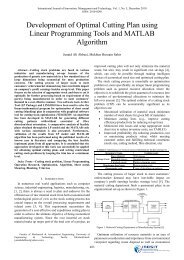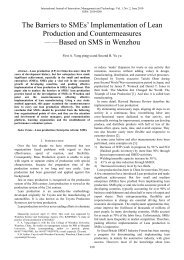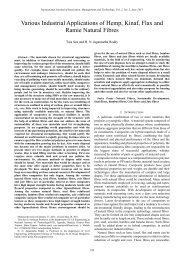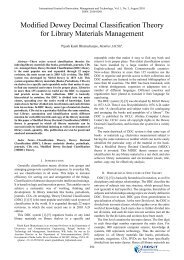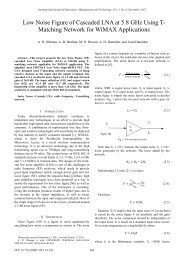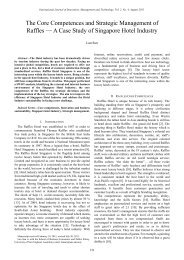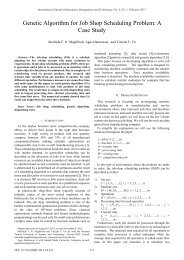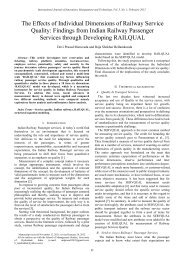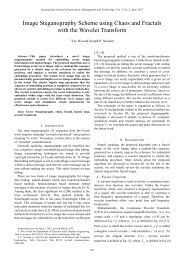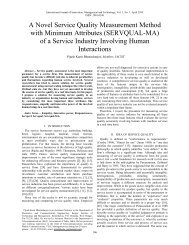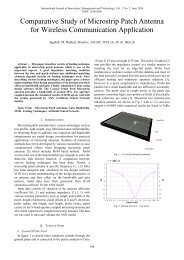Teaching and Evaluation of Business Communication ... - ijimt
Teaching and Evaluation of Business Communication ... - ijimt
Teaching and Evaluation of Business Communication ... - ijimt
You also want an ePaper? Increase the reach of your titles
YUMPU automatically turns print PDFs into web optimized ePapers that Google loves.
International Journal <strong>of</strong> Innovation, Management <strong>and</strong> Technology, Vol. 1, No. 4, October 2010<br />
ISSN: 2010-0248<br />
In a business education program, development <strong>of</strong> a<br />
student’s ability to apply skills <strong>and</strong> knowledge in a variety <strong>of</strong><br />
contexts is a critical need (Broadfoot <strong>and</strong> Black, 2004).<br />
Therefore, assessment <strong>of</strong> student progress in acquiring this<br />
ability becomes imperative. However business education in<br />
India, <strong>and</strong> also in many parts <strong>of</strong> the world, seems to depend<br />
primarily, if not exclusively, upon the traditional examination<br />
system <strong>of</strong> essay <strong>and</strong> problem type examination, quizzes,<br />
multiple choice questions, case studies etc(Juwah, 2003) for<br />
achieving this. One apparent reason for doing so is that the<br />
method is transparent <strong>and</strong> verifiable (Juwah, 2003). Another<br />
reason could be that many business schools, inadvertently or<br />
otherwise, tend to focus more upon content knowledge <strong>and</strong><br />
hence end up using examinations to test such content<br />
knowledge in students (Ogunleye, 2006). However, to be fair<br />
to these schools, it must be said that the tools available to<br />
make assessments are also limited. The need, therefore, is to<br />
design a systematic evaluation design mechanism which, on<br />
one h<strong>and</strong>, should be transparent <strong>and</strong> objective <strong>and</strong>, on the<br />
other h<strong>and</strong>, should achieve the intended purpose. Since the<br />
results <strong>of</strong> any particular assessment device must be accorded<br />
“trust” by the stake holders if the consequences are to be<br />
acceptable, different parts <strong>of</strong> the world continue to be<br />
grappling with assessment challenges (Broadfoot <strong>and</strong> Black,<br />
2004). New tools <strong>of</strong> evaluation like use <strong>of</strong> reflection in<br />
evaluation (Thorpe, 2000), in-basket writing exercise<br />
(Feinberg, 1979), business games (McKenney, 1962) etc. are<br />
constantly being experimented upon <strong>and</strong> developed. Such<br />
experimentation helps in enriching our underst<strong>and</strong>ing <strong>of</strong> the<br />
com plexity <strong>of</strong> the many links that may exist between<br />
assessment <strong>and</strong> learning <strong>and</strong> their various interplays. As is<br />
the case in many other courses, evaluation remains a sensitive<br />
as well as a contentious aspect <strong>of</strong> the business<br />
communication course too. Needless to say, it elicits the same<br />
groans from students <strong>and</strong> instructors. Before proceeding<br />
further, it may be beneficial to remind ourselves <strong>of</strong> the<br />
primary objective <strong>of</strong> a business communication course,<br />
which is to improve communication skills <strong>of</strong> students. These<br />
skills are to be improved <strong>and</strong> assessed as a whole rather than<br />
limiting only to some components, predominantly the written<br />
skills alone.<br />
III. DISSATISFACTION WITH EVALUATION IN BUSINESS<br />
COMMUNICATION<br />
Dissatisfaction with tests currently used to assess<br />
communication ability is neither new nor uncommon. Homer<br />
L Cox, in his study, as far as 1970, observed: “Overall,<br />
educators agreed that they were most dissatisfied with, <strong>and</strong><br />
students were weakest in, ability to communicate in writing;<br />
however, dissatisfaction with tests <strong>and</strong> weakness observed<br />
varied in other areas <strong>of</strong> communication. It is probably safe to<br />
assume that other areas <strong>of</strong> communication ability are not<br />
being tested as frequently as ability to write, <strong>and</strong> weakness in<br />
these other areas may not be accurately assessed. The fact<br />
that other areas are undoubtedly less frequently measured<br />
may indicate that weakness in these areas is less easily<br />
assessed. Most effort seems to be made in improving writing<br />
ability, but writing ability remains the greatest weakness. Of<br />
course, we do not know how much worse the situation might<br />
be if efforts to improve this area were not made; but, on the<br />
other h<strong>and</strong>, we do not know how effective present efforts are.<br />
Writing may lend itself to testing; whether it should get the<br />
greatest amount <strong>of</strong> attention has not been clearly<br />
established.” It must be remembered that good<br />
communication skills comprise the four major aspects <strong>of</strong><br />
communication- LSRW. Of course, ability to distinguish<br />
between fact <strong>and</strong> assumption is also a vital part <strong>of</strong><br />
communication skills as are a number <strong>of</strong> other abilities, but a<br />
test feasible in a limited span <strong>of</strong> time can include only the<br />
items which are basic to all others, namely: LSRW. Ironically,<br />
even all these skills do not get evaluated in the traditional<br />
system <strong>of</strong> examination that is followed in communication<br />
skills evaluation in Indian business schools <strong>and</strong> across.<br />
Generally it is an assessment <strong>of</strong> writing skills through writing<br />
while research has established the importance <strong>of</strong> oral skills as<br />
well with the corporate (Mainkar <strong>and</strong> Avinash, 2008; Maes,<br />
Weldy <strong>and</strong> Icenogle, 1997; Cox, 1970). As mentioned earlier,<br />
research (Cox, 1970) establishes that assessment in areas<br />
other than written skills is less frequently measured whereby<br />
indicating that weakness in these areas is less easily assessed;<br />
hence there appears to be an acute need to develop such tools<br />
as may be helpful to assess these other areas, i.e. non-written<br />
skills.<br />
Present<br />
With such kind <strong>of</strong> challenges, business communication<br />
instructors have now, for long, been toying <strong>and</strong><br />
experimenting with the idea <strong>of</strong> peer assessment <strong>and</strong> it has<br />
gradually emerged as a focal point <strong>of</strong> experimentation <strong>and</strong><br />
research in the current scenario. In fact, most <strong>of</strong> the<br />
experiments in business communication evaluation have, in<br />
some or the other way, involved peer assessment (for<br />
example: experiments by Lynch <strong>and</strong> Golen, 1992;<br />
Gueldenzoph <strong>and</strong> May, 2002 etc).<br />
Peer assessment is an interactive <strong>and</strong> dynamic process that<br />
involves learners in assessing, critiquing <strong>and</strong> making value<br />
judgment on the quality <strong>and</strong> st<strong>and</strong>ard <strong>of</strong> work <strong>of</strong> other<br />
learners (Juwah, 2003), <strong>and</strong> providing feedback to peers to<br />
enable them enhance performance. Peer assessment is one<br />
form <strong>of</strong> innovative assessment (Mowl, 1996, McDowell <strong>and</strong><br />
Mowl, 1996), which aims to improve the quality <strong>of</strong> learning<br />
<strong>and</strong> empower learners, where traditional forms can by-pass<br />
learners' needs. It can include student involvement not only<br />
in the final judgments made <strong>of</strong> student work but also in the<br />
prior setting <strong>of</strong> criteria <strong>and</strong> the selection <strong>of</strong> evidence <strong>of</strong><br />
achievement (Biggs, 1999, Brown, Rust <strong>and</strong> Gibbs, 1994).<br />
Topping (1998) in his paper on peer assessment between<br />
students in colleges <strong>and</strong> universities provides a detailed<br />
typology <strong>of</strong> peer assessment methods. Evidence from<br />
research findings abound supporting the benefits <strong>of</strong> peer<br />
assessment to learners. These include peer learning in a<br />
non-threatening environment, the removal <strong>of</strong> power<br />
domination by the teacher over the student, the involvement<br />
<strong>of</strong> the student in the assessment process (Topping, 1998). By<br />
judging the work <strong>of</strong> others, students gain insight into their<br />
own performance. "Peer <strong>and</strong> self-assessment help students<br />
develop the ability to make judgements, a necessary skill for<br />
study <strong>and</strong> pr<strong>of</strong>essional life" (Brown, Rust <strong>and</strong> Gibbs, 1994).<br />
Brown, Rust <strong>and</strong> Gibbs (1994), Zariski (1996), Race (1998)<br />
383



